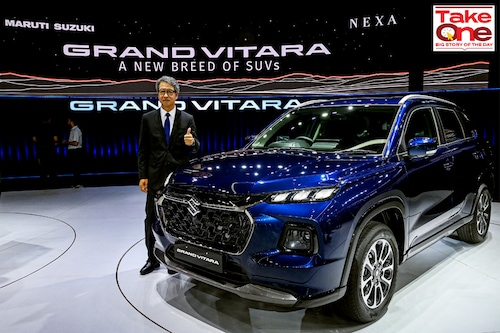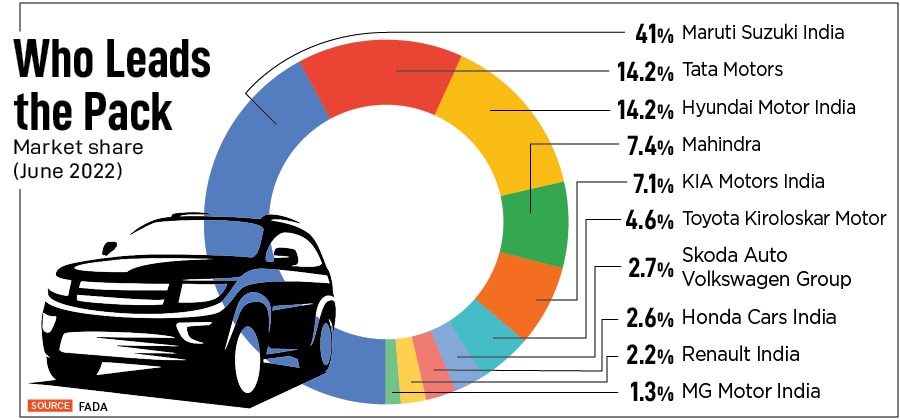How Maruti Suzuki is gearing up to win back its lost SUV market
The carmarker is foraying into the segment with two launches in three weeks to corner market share in the category that, in India, is among the fastest-growing in the world


India’s largest carmaker is going all guns blazing. In a span of just three weeks, Maruti Suzuki has launched two new vehicles—both in the SUV segment—where it had been consistently losing ground for the past few years.
On June 30, the company launched the next generation variant of its entry-level SUV, Maruti Suzuki Brezza, six years after it was first introduced. Then, three weeks later, on July 21, the Gurugram-headquartered company showcased its premium mid-size SUV offering, the Grand Vitara, expected to finally give the carmaker a much-needed foothold in the booming SUV market.
While the Brezza’s pricing starts at Rs 7.99 lakh, the Grand Vitara—which rivals popular SUVs such as Hyundai Creta, Kia Seltos, Tata Harrier, and MG Hector among others—is expected to start retailing at Rs 10 lakh. The Grand Vitara has already raised eyebrows for offering range-topping fuel efficiency of 28 km for its hybrid offering.
Since the launches, Maruti claims to have received 62,000 bookings for the Brezza, averaging some 1,500 a day, while the Grand Vitara, which will begin sales in September, has received some 18,000 bookings. “This is a fairly good number," Shashank Srivastava, senior executive director, marketing & sales, told Forbes India in an interview. “For the Grand Vitara, production will begin in August-end, and we hope to start the sale in September. We know about the price expectation from our clients."
Of course, pricing will be critical for the carmaker, especially since it has a lot of catching up to do in the Indian SUV market. In just two years, the carmaker has seen its market share dwindle by nearly 10 percent even as other homegrown carmakers managed some stellar turnaround of their fortunes. Much of Maruti’s misfortunes, of course, were the company’s own doing—having missed the bus when it comes to building a portfolio of SUVs—in the world’s fifth largest automobile market. As of June 2022, the company has a market share of around 41 percent, down from 50 percent two years ago, according to the Federation of Automobile Dealers Association.
That steep decline was due to the company’s paltry market share in the SUV business, where the company currently corners some 11 percent of the category. “Maruti Suzuki’s market share in the non-SUV segment is at 65 percent-plus. This has been increasing. In fact, it"s the highest you have got in the last 20 years," Srivastava adds. “However, when you combine the market share with SUV, then our market share has fallen around 45 percent. Clearly, the market share in the SUV segment is dragging the overall market share down."
By numerous estimates, and even according to Maruti Suzuki, SUVs now account for about 40 percent of the country’s overall market. About 39 percent of the market is held by hatchbacks while the remaining involves sedans and vans among others. “Because the SUV segment has now become 40 percent of the market, it is a large segment and bigger than hatches. So, it is obvious that if you want to achieve the objective of 50 percent market share right, Maruti Suzuki needs to have a good market share in the SUV segment," says Srivastava.

While the company was an early mover in the SUV segment with the Maruti Suzuki Brezza, it had lagged other carmakers in the country in the segment in the past few years. It was around the same time that automakers—from the likes of Hyundai and Tata—turned their attention away from sedans and hatchbacks to SUVs, and, in the process, managed to corner a significant of the domestic market.
“So, we looked at the markets and we found that there are two major segments," Srivastava says. “One is the entry SUV, which is the compact segment. That market is about 22 percent of the overall industry, and it is the largest, sub-segment of the industry now. Premium or mid-size SUVs used to be the highest at 23 percent, and last year, it fell to 21 percent. And this (entry) increased from about 19 percent to 22."
Last year, India sold 30.69 lakh passenger vehicles, which means over 12 lakh vehicles were in the SUV segment. Of this, over 6.5 lakh vehicles were in the compact segment with the remaining falling in the mid-size SUV segment comprising Hyundai Creta, Kia Seltos, and Jeep Compass among others. That segment is expected to grow at a CAGR of 10 percent and double in the next 3 to 4 years.
“Now we have the grand Vitara, which should give us good volume and market share, thereby increasing market share, and consequently market share in the SUV and then in the overall market. That will help us achieve our 50 percent target," Srivastava says.
While the company remains tightlipped about new models, two more SUVs are likely to be brought out from its stables shortly. “What we have found over the years is that if a segment grows, many sub-segments emerge," Srivastava says. “In the hatches, there was the 800 cc Maruti. Then you had the Santro and Zen and Swift and Baleno. Depending on the consumer requirement, similarly, we expect that in the SUV segment too."
That means, the company is keeping a firm eye on emerging segments in the SUV category, including the likes of lifestyle SUVs such as the Mahindra, and could even bring the globally popular Suzuki Jimny to the country. “We are studying whether we can have more SUVs in the sub-segments which are emerging," Srivastava says. “So, I would expect more (launches) going forward."
In its SUV battle, Maruti is also helped largely by a partnership with Toyota, which will manufacture the company’s Grand Vitara from its manufacturing plant in Bidadi in Karnataka. In 2019, Toyota and Suzuki announced that the two companies had entered into a long-term partnership for promoting collaboration in new fields, including autonomous driving. In India, Toyota had begun badging its vehicles that are built on Maruti Suzuki’s platforms, such as the Brezza and Baleno.
“There are currently more than 50 SUVs available to choose from for India customers," adds Sharma of Nomura. “This fixation of Indian customers with taller, robust road presence, high ground clearance is likely to continue. We have seen this happen all across global markets, it happened in China, Brazil, and the US and most likely it will happen to us also. So regardless of MSIL’s late entry in the true SUV segment, given their deep-rooted cost engineering precision, network strength, and Toyota’s alliance synergies, I am sure they will be able to cover this gradient much faster than their peers."
Meanwhile, even as India’s automobile sector pivots towards SUVs, Maruti knows it must draw a fine balance between SUVs and hatchbacks, where the company has a significant market share. The company expects the share of SUVs to grow to 50 percent before it plateaus, thereby ensuring a 50 percent split between sedans/hatchbacks and SUVs.
“We are predicting something like a 50 percent because we have found that in the other countries, which have matured earlier than Indian market like the US, plateauing seems to be happening around that 49 to 52 percent range," Srivastava says. “We really don’t know how it will evolve going forward, but I would expect some plateauing to happen around that."
First Published: Jul 26, 2022, 14:44
Subscribe Now